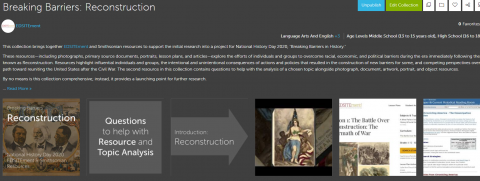The Reconstruction Era

"The Emancipation of the Negroes, January, 1863—The Past and the Future"
"The law on the side of freedom is of great advantage
only when there is power to make that law respected.”
– Frederick Douglass
The surrender by Confederate General Robert E. Lee to Union General Ulysses S. Grant on April 9, 1865 at Appomattox marked the end of one period of violence and regional difference in the United States and the beginning of another. Reconstruction (1865-1877) is the period of time following the American Civil War (1861-1865) when some politicians and citizens sought to reunify the nation, integrate freed slaves into society and the economy, establish political and economic rights for all African Americans, and determine what role the U.S. government would play in implementing these policies while preventing another civil war from breaking out. On the contrary, some politicians and citizens resented the prospect of there once again being a single nation, rejected equal protection under the law and birthright citizenship in the United States, no matter a person's race, and refused to accept the termination of slavery as an institution and practice. Historian and scholar W. E. B. DuBois wrote of this complex time that "The slave went free; stood a brief moment in the sun; then moved back again toward slavery."
This Teacher’s Guide provides compelling questions to frame a unit of study and inquiry projects, along with activity ideas that include use of newspapers from the era and resources for social studies, ELA, and music education. Our NEH sponsored multimedia resources provide a look into the history, as well as contemporary connections for students to engage in a change over time analysis. Teachers can also access our Reconstruction Learning Lab collection of artifacts and other sources, as well as a seminar and DBQ activity for students in grades 8-12 that brings together primary source documents and supports student inquiry.
Guiding Questions
To what extent did Reconstruction forge a “more perfect union”?
Did Reconstruction extend or undermine democracy in the United States?
Why did Black Codes and Jim Crow exist?
How did local and regional differences affect the ways in which Reconstruction was implemented?
What did the Reconstruction era mean from economic and labor rights?
To what extent did Reconstruction resolve disagreements over political rights and representation?
Was Reconstruction a second American Revolution?
What did the Reconstruction Amendments mean for citizenship in the United States?
What is the lasting legacy of Reconstruction era policies and practices?
Should reparations be provided to the descendants of slaves?

